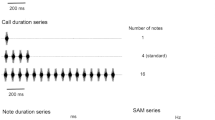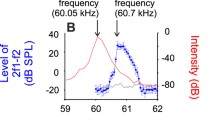Abstract
Widely divergent vertebrates share a common central temporal mechanism for representing periodicities of acoustic waveform events. In the auditory nerve, periodicities corresponding to frequencies or rates from about 10 Hz to over 1,000 Hz are extracted from pure tones, from low-frequency complex sounds (e.g., 1st harmonic in bullfrog calls), from mid-frequency sounds with low-frequency modulations (e.g., amplitude modulation rates in cat vocalizations), and from time intervals between high-frequency transients (e.g., pulse-echo delay in bat sonar). Time locking of neuronal responses to periodicities from about 50 ms down to 4 ms or less (about 20–300 Hz) is preserved in the auditory midbrain, where responses are dispersed across many neurons with different onset latencies from 4–5 to 20–50 ms. Midbrain latency distributions are wide enough to encompass two or more repetitions of successive acoustic events, so that responses to multiple, successive periods are ongoing simultaneously in different midbrain neurons. These latencies have a previously unnoticed periodic temporal pattern that determines the specific times for the dispersed on-responses.





Similar content being viewed by others
Abbreviations
- AM:
-
Amplitude modulation
- FM:
-
Frequency modulation
- PRR:
-
Pulse repetition rate
- nVIII:
-
Auditory nerve
- TS:
-
Torus semicircularis
- IC:
-
Inferior colliculus
- VS:
-
Vector strength
References
Bee MA, Bowling AC (2002) Socially-mediated pitch alteration by territorial male bullfrogs, Rana catesbeiana. J Herpetol 36:140–143
Brugge JF, Anderson DJ, Hind JE, Rose JE (1969) Time structure of discharges in single auditory nerve fibers of the squirrel monkey in response to complex periodic sounds. J Neurophysiol 32:386–401
Brugge JF, Nourski KV, Oya H, Reale RA, Kawasaki H, Steinschneider M, Howard MA III (2009) Coding of repetitive transients by auditory cortex on Heschyl’s gyrus. J Neurophysiol 102:2358–2374
Cariani PA, Delgutte B (1996) Neural correlates of the pitch of complex tones. I. Pitch and pitch salience. J Neurophysiol 76:1698–1716
Cassedy JH, Covey E (1996) A neuroethological theory of the operation of the inferior colliculus. Brain Behav Evol 47:311–336
Cedolin L, Delgutte B (2005) Pitch of complex tones: rate-place and interspike interval representations in the auditory nerve. J Neurophysiol 94:347–362
Dalland J (1965) Hearing sensitivity in bats. Science 150:1185–1186
Edamatsu H, Suga N (1993) Differences in response properties of neurons between two delay-tuned areas in the auditory cortex of the mustached bat. J Neurophysiol 69:1700–1712
Fay RR (1988) Hearing in vertebrates: a psychophysics databook. Hill-Fay, Winnetka, IL
Ferragamo MJ, Haresign T, Simmons JA (1998) Frequency tuning, latencies, and responses to FM sweeps in the inferior colliculus of the echolocating bat, Eptesicus fuscus. J Comp Physiol A 182:65–79
Hainfeld C, Boatright-Horowitz SL, Boatright-Horowitz SS, Simmons AM (1996) Discrimination of phase spectra in complex sounds by the bullfrog, Rana catesbeiana. J Comp Physiol A 178:75–87
Haplea S, Covey E, Casseday JH (1994) Frequency tuning and response latencies at three levels in the brainstem of the echolocating bat, Eptesicus fuscus. J Comp Physiol A 174:671–683
Heffner RS, Heffner HE (1985) Hearing range of the domestic cat. Hear Res 19:85–88
Heffner H, Whitfield IC (1976) Perception of the missing fundamental by cats. J Acoust Soc Am 59:915–919
Joris PX, Schreiner CE, Rees A (2004) Neuronal processing of amplitude-modulated sounds. Physiol Rev 84:541–577
Kiang NYS, Watanabe T, Thomas T, Clark LF (1965) Discharge patterns of single fibers in the cat’s auditory nerve. MIT Press, Cambridge, MA
Koay G, Heffner HE, Heffner RS (1997) Audiogram of the big brown bat (Eptesicus fuscus). Hear Res 105:202–210
Langner G (1981) Evidence for neuronal periodicity detection in the auditory system of the guinea fowl: implications for pitch analysis in the time domain. Exp Brain Res 52:333–355
Langner G, Schreiner C (1988) Periodicity coding in the inferior colliculus of the cat. I. Neuronal mechanisms. J Neurophysiol 60:1799–1822
Licklider JCR (1951) A duplex theory of pitch perception. Experientia 7:128–134
Liu L-F, Palmer AR, Wallace MN (2006) Phase-locked responses to pure tones in the inferior colliculus. J Neurophysiol 95:1926–1935
Lu Y, Jen PH-S, Wu M (1998) GABAergic disinhibition affects responses of bat inferior collicular neurons to temporally patterned sound pulses. J Neurophysiol 79:2303–2315
Lyon R, Shamma S (1996) Auditory representation of timbre and pitch. In: Hawkins HL, McMullen TA, Popper AN, Fay RR (eds) Auditory computation. Springer, New York, pp 221–270
Ma X, Suga N (2008) Corticofugal modulation of the paradoxical latency shifts of inferior collicular neurons. J Neurophysiol 100:1127–1134
Manley GA, Fastl H, Kössl M, Oeckinhhaus H, Klump G (eds) (2000) Auditory worlds: sensory analysis and perception in animals and man. Wiley-VCH, Weinheim, Germany
Megela-Simmons A, Moss CF, Daniel KM (1985) Behavioral audiograms of the bullfrog (Rana catesbeiana) and the green tree frog (Hyla cinerea). J Acoust Soc Am 78:1236–1244
Moore BCJ (2003) An introduction to the psychology of hearing, 5th edn. Academic Press, San Diego
Neuweiler G (1990) Auditory adaptations for prey capture in echolocating bats. Physiol Rev 70:615–641
Nicastro N (2004) Perceptual and acoustic evidence for species-level differences in meow vocalizations by domestic cats (Felis catus) and African wild cats (Felis silvestris lybica). J Comp Psych 118:287–296
Nicastro N, Owren MJ (2003) Classification of domestic cat (Felis catus) vocalizations by native and experienced human listeners. J Comp Psych 117:44–52
Pinheiro AD, Wu M, Jen PH (1991) Encoding repetition rate and duration in the inferior colliculus of the big brown bat, Eptesicus fuscus. J Comp Physiol A 169:69–85
Poussin C, Simmons JA (1982) Low-frequency hearing sensitivity in the echolocating bat, Eptesicus fuscus. J Acoust Soc Am 72:340–342
Rees A, Langner G (2005) Temporal coding in the auditory midbrain. In: Winer JA, Schreiner CE (eds) The inferior colliculus. Springer, New York, pp 346–376
Reimer K (1987) Coding of sinusoidally amplitude modulated acoustic stimuli in the inferior colliculus of the rufous horseshoe bat, Rhinolophus rouxi. J Comp Physiol A 161:305–313
Ritsma RJ (1962) Existence region of the tonal residue. I. J Acoust Soc Am 34:1224–1229
Rose JE, Brugge JF, Anderson DJ, Hind JE (1967) Phase-locked response to low-frequency tones in single auditory nerve fibers of the squirrel monkey. J Neurophysiol 30:769–793
Sanderson MI, Simmons JA (2000) Neural responses to overlapping FM sounds in the inferior colliculus of echolocating bats. J Neurophysiol 83:1840–1855
Sanderson MI, Simmons JA (2005) Target representation of naturalistic echolocation sequences in single unit responses from the inferior colliculus of big brown bats. J Acoust Soc Am 118:3352–3361
Schwartz JJ, Simmons AM (1990) Encoding of a spectrally-complex communication sound in the bullfrog’s auditory nerve. J Comp Physiol A 166:489–500
Semal C, Demany L (1990) The upper limit of musical pitch. Music Percept 8:165–175
Shamma S (2001) On the role of space and time in auditory processing. Trends Cogn Sci 5:340–348
Simmons JA, Ferragamo MJ, Saliant PA, Haresign T, Wotton JM, Dear SP, Lee DN (1995) Auditory dimensions of acoustic images in echolocation. In: Popper AN, Fay RR (eds) Hearing by bats. Springer, New York, pp 146–190
Simmons AM, Shen Y, Sanderson MI (1996a) Neural and computational basis for periodicity extraction in frog peripheral auditory system. Audit Neurosci 2:109–133
Simmons JA, Saillant PA, Ferragamo MJ, Haresign T, Dear SP, Fritz JB, McMullen TA (1996b) Auditory computations for acoustic imaging in bat sonar. In: Hawkins HL, McMullen TA, Popper AN, Fay RR (eds) Auditory computation. Springer, New York, pp 401–468
Simmons AM, Sanderson MI, Garabedian CE (2000) Representation of waveform periodicity in the auditory midbrain of the bullfrog, Rana catesbeiana. J Assoc Res Otolaryngol 1:2–24
Stevens KN (1998) Acoustic phonetics. MIT Press, Cambridge, MA
Suga N, Olsen JF, Butman JA (1990) Specialized subsystems for processing biologically important complex sounds: cross-correlation analysis for ranging in the bat’s brain. Cold Spring Harbor Symp Quant Biol 55:585–597
Suggs DN, Simmons AM (2005) Information theory analysis of patterns of modulation in the advertisement call of the male bullfrog, Rana catesbeiana. J Acoust Soc Am 117:2330–2337
Walker KMM, Bizley JK, King AJ, Schnupp JWH (2010) Cortical encoding of pitch: recent results and open questions. Hear Res. doi:10.1016/j.heares.2010.04.015
Wever EG (1949) Theory of hearing. Wiley, New York
Wu CH, Jen PH (2008) Echo frequency selectivity of duration-tuned inferior collicular neurons of the big brown bat, Eptesicus fuscus, determined with pulse-echo pairs. Neuroscience 156:1028–1038
Yost WA, Hill R (1978) Strength of the pitches associated with ripple noise. J Acoust Soc Am 64:485–492
Young ED, Sachs MB (1979) Representation of steady-state vowels in the temporal aspects of the discharge patterns of populations of auditory-nerve fibers. J Acoust Soc Am 66:1381–1403
Acknowledgments
This work was supported by ONR Grant # N00014-04-l-0415, by NIH Grant # R01-MH069633, and by NSF Grant # IOS-0843522 (JAS), and by NIH grant DC05257 (AMS). We thank the members of the Brown bat and frog labs for discussion of this work.
Author information
Authors and Affiliations
Corresponding author
Rights and permissions
About this article
Cite this article
Simmons, J.A., Megela Simmons, A. Bats and frogs and animals in between: evidence for a common central timing mechanism to extract periodicity pitch. J Comp Physiol A 197, 585–594 (2011). https://doi.org/10.1007/s00359-010-0607-4
Received:
Revised:
Accepted:
Published:
Issue Date:
DOI: https://doi.org/10.1007/s00359-010-0607-4




